There are no Homosexuals in Iran . Mehmoud Ahmadenijad
I found this very good article here.The author has reviewed the book on history of homosexuality in Iran by the famous Iranian academic Janet Afray , who is a Professor of History and Women Studies at Purdue University and also is the president of International Society of Iranian Scholars. The book is called “Sexual Politics in Modern Iran”, the deals with the constructions of gender and sexuality over a wider historical period. Her extensive reading of the ancient texts have demonstrated the rather “normal” nature of homosexual relationships in Pre-modern Iran. She demonstrates that the violent homophobia in Iran is the result of Western modern influence. I differ with the assertion on Marxist oriented “homophobia” . The fact of the matter is that with The Glorious Russian Revolution of 1917 homosexuality became de-criminalized in one of the first acts by the revolutionary government. The claim of “well documented condemnation of homosexuality by Marx” unfortunately is not very sound one. Passages from Engels have frequently been quoted by the anti-communists to spread of “myth homophobia inherent in communism”. These passages are usually taken out of context and looked outside the “scientific base” of that time to condemn Engels. The Homosexual Liberation Movement always had a strong Marxist element. The Marxist social democratic parties of Germany and Europe were the first to show sensitivity to homosexual cause and the later Gay Liberation Movement always had a strong Marxist element. The Stalinist regime reversed a lot of Leninist reforms especially those regarding sexual freedoms and women rights and restored the “family”. These crimes should not be attributed to Marx and the Marxists. Anyway the article is very good and i hope you like it
Shaheryar Ali
IRAN’S HIDDEN HOMOSEXUAL HISTORY
Doug Ireland
When Iranian President Mahmoud Ahmadinejad made his infamous claim at a September 2007 Columbia University appearance that “”In Iran, we don’t have homosexuals like in your country,” the world laughed at the absurdity of this pretense.
Now, a forthcoming book by a leading Iranian scholar in exile, which details both the long history of homosexuality in that nation and the origins of the campaign to erase its traces, not only provides a superlative reply to Ahmadinejad, but demonstrates forcefully that political homophobia was a Western import to a culture in which same-sex relations were widely tolerated and frequently celebrated for well over a thousand years.
“Sexual Politics in Modern Iran,” to be published at the end of next month by Cambridge University Press, is a stunningly researched history and analysis of the evolution of gender and sexuality that will provide a transcendent tool both to the vibrant Iranian women’s movement today fighting the repression of the ayatollahs and to Iranian same-sexers hoping for liberation from a theocracy that condemns them to torture and death.
Its author, Janet Afary, president of the International Society of Iranian Scholars, is a professor of history and women’s studies at Purdue University who has already published several authoritative works on Iranian sexual politics, notably the revealing and award-winning “Foucault and the Iranian Revolution: Gender and the Seductions of Islam” (2005), in which she already demonstrated a remarkable sympathy for gay and lesbian people.
In her new book, Afary’s extensive section on pre-modern Iran, documented by a close reading of ancient texts, portrays the dominant form of same-sex relations as a highly-codified “status-defined homosexuality,” in which an older man – presumably the active partner in sex – acquired a younger partner, or amrad.
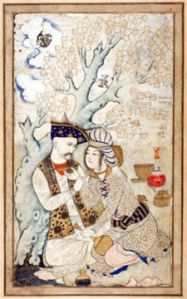
Shah Abbas and Wine Boy. Louvre
Afary demonstrates how, in this period, “male homoerotic relations in Iran were bound by rules of courtship such as the bestowal of presents, the teaching of literary texts, bodybuilding and military training, mentorship, and the development of social contacts that would help the junior partner’s career. Sometimes men exchanged vows, known as brotherhood sigehs [a form of contractual temporary marriage, lasting from a few hours to 99 years, common among heterosexuals] with homosocial or homosexual overtones.
“These relationships were not only about sex, but also about cultivating affection between the partners, placing certain responsibilities on the man with regard to the future of the boy. Sisterhood sigehs involving lesbian practices were also common in Iran. A long courtship was important in these relations. The couple traded gifts, traveled together to shrines, and occasionally spent the night together. Sigeh sisters might exchange vows on the last few days of the year, a time when the world ‘turned upside down,’ and women were granted certain powers over men.”
Examples of the codes governing same-sex relations were to be found in the “Mirror for Princes genre of literature (andarz nameh) [which] refers to both homosexual and heterosexual relations. Often written by fathers for sons, or viziers for sultans, these books contained separate chapter headings on the treatment of male companions and of wives.”
One such was the Qabus Nameh (1082-1083), in which a father advises a son: “As between women and youths, do not confine your inclinations to either sex; thus you may find enjoyment from both kinds without either of the two becoming inimical to you… During the summer let your desires incline toward youths, and during the winter towards women.”
Afary dissects how “classical Persian literature (twelfth to fifteenth centuries)…overflowed with same-sex themes (such as passionate homoerotic allusions, symbolism, and even explicit references to beautiful young boys.)” This was true not only of the Sufi masters of this classical period but of “the poems of the great twentieth-century poet Iraj Mirza (1874-1926)… Classical poets also celebrated homosexual relationships between kings and their pages.”
Afary also writes that “homosexuality and homoerotic expressions were embraced in numerous other public spaces beyond the royal court, from monasteries and seminaries to taverns, military camps, gymnasiums, bathhouses, and coffeehouses… Until the mid-seventeenth century, male houses of prostitution (amrad khaneh) were recognized, tax-paying establishments.”
While Afary explores the important role of class in same-sex relations, she also illuminates how “Persian Sufi poetry, which is consciously erotic as well as mystical, also celebrated courtship rituals between [men] of more or less equal status… The bond between lover and beloved was… based on a form of chivalry (javan mardi). Love led one to higher ethical ideals, but love also constituted a contract, wherein the lover and the beloved had specific obligations and responsibilities to one another, and the love that bound them both… Sufi men were encouraged to use homoerotic relations as a pathway to spiritual love.”
Unmistakably lesbian sigeh courtship rituals, which continued from the classical period into the twentieth century, were also codified: “Tradition dictated that one [woman] who sought another as ‘sister’ approached a love broker to negotiate the matter. The broker took a tray of sweets to the prospective beloved. In the middle of the tray was a carefully placed dildo or doll made of wax or leather. If the beloved agreed to the proposal, she threw a sequined white scarf (akin to a wedding veil) over the tray… If she was not interested, she threw a black scarf on the tray before sending it back.”
As late as the last half of the 19th century and the early years of the 20th, “Iranian society remained accepting of many male and female homoerotic practices… Consensual and semi-open pederastic relations between adult men and amrads were common within various sectors of society.” What Afary terms a “romantic bisexuality” born in the classical period remained prevalent at court and among elite men and women, and “a form of serial love (‘eshq-e mosalsal) was commonly practiced [in which] their love could shift back and forth from girl to boy and back to girl.”
In the court of Naser al-Din Shah, who ruled Persia from 1848 to 1896, keeping boy concubines was still an acceptable practice, and the shah himself (in addition to his wives and harem) had a young male lover, Malijak, whom he “loved more than anyone else.” In his memoirs, Malijak recalled proudly, “the king’s love for me reached the point where it is impossible for me to write about it… [He] held me in his arms and kissed me as if he were kissing one of his great beloveds.”
In a lengthy section of her book entitled “Toward a Westernized Modernity,” Afary demonstrates how the trend toward modernization which emerged during the Constitutional Revolution of 1906 and which gave the Persian monarchy its first parliament was heavily influenced by concepts harvested from the West.
One of her most stunning revelations is how an Azeri-language newspaper edited and published in the Russian Caucuses, Molla Nasreddin (or MN, which appeared from 1906 to 1931) influenced this Iranian Revolution with a “significant new discourse on gender and sexuality,” sharing Marx’s well-documented contempt for homosexuals. With an editorial board that embraced Russian social democratic concepts, including women’s rights, MN was also “the first paper in the Shi’i Muslim world to endorse normative heterosexuality,” echoing Marx’s well-documented contempt for homosexuality. Afary writes that “this illustrated satirical paper, which circulated among Iranian intellectuals and ordinary people alike, was enormously popular in the region because of its graphic cartoons.”
MN conflated homosexuality and pedophilia, and attacked clerical teachers and leaders for “molesting young boys,” played upon feelings of “contempt” for passive homosexuals, suggested that elite men who kept amrad concubines “had a vested interested in maintaining the (male) homosocial public spaces where semi-covert pederasty was tolerated,” and “mocked the rites of exchanging brotherhood vows before a mollah and compared it to a wedding ceremony.” It was in this way that a discourse of political homophobia developed in Europe, which insisted that only heterosexuality could be the norm, was introduced into Iran.
MN‘s attacks on homosexuality “would shape Iranian debates on sexuality for the next century,” and it “became a model for several Iranian newspapers of the era,” which echoed its attacks on the conservative clergy and leadership for homosexual practices. In the years that followed, “Iranian revolutionaries commonly berated major political figures for their sexual transgressions,” and “revolutionary leaflets accused adult men of having homosexual sex with other adult men, ‘of thirty-year-olds propositioning fifty-year-olds and twenty-year-olds propositioning forty-year-olds, right in front of the Shah.’ Some leaflets repeated the old allegation that major political figures had been amrads in their youth.”
Subsequently, “leading constitutionalists enthusiastically joined the campaign against homosexuality,” writes Afary, noting that “the influential journal Kaveh (1916-1921), published in exile in Berlin and edited by the famous constitutionalist Hasan Taqizadeh, had led the movement of opinion against homosexuality… Their notion of modernization now included the normalization of heterosexual eros and the abandonment of all homosexual practices and even inclinations.”
When Reza Kahn overthrew the monarchy’s Qajar dynasty and made himself shah in 1925, he ushered in a new wave of reforms and modernization that included attempts to outlaw homosexuality entirely and a ferocious – ultimately successful – assault on classical Persian poetry. Iraj Mirza, previously known for his homoerotic poems, “joined other leading political figures of this period in encouraging compulsory heterosexuality.” These politicians and intellectuals insisted that “true patriotism required switching one’s sexual orientation from boys to women… Other intellectuals and educators pressed for the elimination of poems with homosexual themes from school textbooks.”
Leading this crusade was a famous historian and prolific journalist, Ahmad Kasravi, “who helped shape many cultural and educational policies during the 1930s and 1940s.” Kasravi founded a nationalist movement, Pak Dini (Purity of Religion), which developed a broad following. An admirer of MN, Kasravi preached that “homosexuality was a measure of cultural backwardness,” that Sufi poets of homoeroticism led “parasitic” lives, and that their queer poetry “was dangerous and had

Youth and Suitors
to be eliminated.”
Kasravi’s Pak Dini movement “went so far as to institute a festival of book burning, held on winter solstice. Books deemed harmful and amoral were thrown into a bonfire in an event that seemed to echo the Nazi and Soviet-style notions of eliminating ‘degenerate’ art.” Eventually, Prime Minister Mahmoud Jam, who held office from 1935 to 1939, acceded to Kasravi’s demand that homoerotic poems be banned entirely from daily newspapers.
Kasravi “based his opposition to the homoeroticism of classical poetry on several assumptions. He expected the young generation to study Western sciences in order to rebuild the nation, and he regarded Sufi poetry as a dangerous diversion. As preposterous as it might sound, Kasravi also argued that the revival of Persian poetry was a grand conspiracy concocted by British and German Orientalists to divert the nation’s youth from the revolutionary legacy of the Constitutional Revolution and to encourage… immoral pursuits.”
Afary adds sorrowfully that “most supporters of women’s rights sympathized with Kasravi’s project because he encouraged the cultivation of monogamous, heterosexual love in marriage… In this period, neither Kasravi nor feminists distinguished between rape or molestation of boys and consensual same-sex relations between adults.”
The expansion of radio, television, and print media in the 1940s – including a widely read daily, Parcham, published from 1941 by Kasravi’s Pak Dini movement – resulted in a nationwide discussion about the evils of pederasty and, ultimately, in significant official censorship of literature. References to same-sex love and the love of boys were eliminated in textbooks and even in new editions of classical poetry. “Classical poems were now illustrated by miniature paintings celebrating heterosexual, rather than homosexual, love and students were led to believe that the love object was always a woman, even when the text directly contradicted that assumption,” Arafy writes.
In the context of a triumphant censorship that erased from the popular collective memory the enormous literary and cultural heritage of what Afary terms “the ethics of male love” in the classical Persian period, it is hardly surprising as Afary earlier noted in “Foucault and the Iranian Revolution” that the virulence of the current Iranian regime’s anti-homosexual repression stems in part from the role homosexuality played in the 1979 revolution that brought the Ayatollah Khomeini and his followers to power.
In that earlier work, she and her co-author, Kevin B. Anderson, wrote: “There is… a long tradition in nationalist movements of consolidating power through narratives that affirm patriarchy and compulsory heterosexuality, attributing sexual abnormality and immorality to a corrupt ruling elite that is about to be overthrown and/or is complicit with foreign imperialism. Not all the accusations leveled against the [the deposed shah of Iran, and his] Pahlevi family and their wealthy supporters stemmed from political and economic grievances. A significant portion of the public anger was aimed at their ‘immoral’ lifestyle. There were rumors that a gay lifestyle was rampant at the court. The shah’s prime minister, Amir Abbas Hoveyda, was said to have been a homosexual. The satirical press routinely lampooned him for his meticulous attire, the purple orchid in his lapel, and his supposed marriage of convenience. The shah himself was rumored to be bisexual. There were reports that a close male friend of the shah from Switzerland, a man who knew him from their student days in that country, routinely visited him.
“But the greatest public outrage was aimed at two young, elite men with ties to the court who held a mock wedding ceremony. Especially to the highly religious, this was public confirmation that the Pahlevi house was corrupted with the worst kinds of sexual transgressions, that the shah was no longer master of his own house. These rumors contributed to public anger, to a sense of shame and outrage, and ultimately were used by the Islamists in their calls for a revolution.”
Soon after coming to power in 1979, Ayatollah Khomeini established the death penalty for homosexuality.
In “Sexual Politics in Modern Iran,” Afary sums up the situation for homosexuals under the Ahmadinejad regime in this way: “While the shari’a [Islamic law] requires either the actual confession of the accused or four witnesses who observed them in flagrante delicto, today’s authorities look only for medical evidence of penetration in homosexual relationships. Upon finding such evidence, they pronounce the death sentence. Because execution of men on charges of homosexuality has prompted international outrage, the state has tended to compound these charges with others, such as rape and pedophilia. Continual use of these tactics has undermined the status of Iran’s gay community and attenuated public sympathy for them. Meanwhile, many Iranians believe that pedophilia is rampant in the religious cities of Qum and Mashad, including in the seminaries, where temporary marriage and prostitution are also pervasive practices.” (Full disclosure: in her section on gays in today’s Iran, Afary cites my reporting several times and thanks me in the book’s acknowledgements for sharing materials and insights with her.)
In this necessarily truncated summary of some of Afary’s most significant and nuanced findings and revelations with respect to homosexuality, it is impossible to do justice to the full sweep and scope of “Sexual Politics in Iran,” the larger part of which is devoted to the role of Iranian women, and to their struggles for freedom which began in the 19th century. But as Afary herself writes, “[F]or a very long time even talking about the pervasive homoeroticism of the region’s premodern culture had been labeled ‘Orientalism’… [but] increasingly I found that one could not simply talk about gender and women’s rights, particularly rights within marriage, without addressing the subject of same-sex relations.”
This she has done with uncommon sensitivity, intellectual rigor, engagement, subtlety, and skill.
And for that, both Iranian lesbians and gays and feminists in that nation owe Afary an enormous debt of gratitude, as do all of us concerned with sexual liberation for everyone worldwide
When Iranian President Mahmoud Ahmadinejad made his infamous claim at a September 2007 Columbia University appearance that “”In Iran, we don’t have homosexuals like in your country,” the world laughed at the absurdity of this pretense.
Now, a forthcoming book by a leading Iranian scholar in exile, which details both the long history of homosexuality in that nation and the origins of the campaign to erase its traces, not only provides a superlative reply to Ahmadinejad, but demonstrates forcefully that political homophobia was a Western import to a culture in which same-sex relations were widely tolerated and frequently celebrated for well over a thousand years.
“Sexual Politics in Modern Iran,” to be published at the end of next month by Cambridge University Press, is a stunningly researched history and analysis of the evolution of gender and sexuality that will provide a transcendent tool both to the vibrant Iranian women’s movement today fighting the repression of the ayatollahs and to Iranian same-sexers hoping for liberation from a theocracy that condemns them to torture and death.
Its author, Janet Afary, president of the International Society of Iranian Scholars, is a professor of history and women’s studies at Purdue University who has already published several authoritative works on Iranian sexual politics, notably the revealing and award-winning “Foucault and the Iranian Revolution: Gender and the Seductions of Islam” (2005), in which she already demonstrated a remarkable sympathy for gay and lesbian people.
In her new book, Afary’s extensive section on pre-modern Iran, documented by a close reading of ancient texts, portrays the dominant form of same-sex relations as a highly-codified “status-defined homosexuality,” in which an older man – presumably the active partner in sex – acquired a younger partner, or amrad.
Afary demonstrates how, in this period, “male homoerotic relations in Iran were bound by rules of courtship such as the bestowal of presents, the teaching of literary texts, bodybuilding and military training, mentorship, and the development of social contacts that would help the junior partner’s career. Sometimes men exchanged vows, known as brotherhood sigehs [a form of contractual temporary marriage, lasting from a few hours to 99 years, common among heterosexuals] with homosocial or homosexual overtones.
“These relationships were not only about sex, but also about cultivating affection between the partners, placing certain responsibilities on the man with regard to the future of the boy. Sisterhood sigehs involving lesbian practices were also common in Iran. A long courtship was important in these relations. The couple traded gifts, traveled together to shrines, and occasionally spent the night together. Sigeh sisters might exchange vows on the last few days of the year, a time when the world ‘turned upside down,’ and women were granted certain powers over men.”
Examples of the codes governing same-sex relations were to be found in the “Mirror for Princes genre of literature (andarz nameh) [which] refers to both homosexual and heterosexual relations. Often written by fathers for sons, or viziers for sultans, these books contained separate chapter headings on the treatment of male companions and of wives.”
One such was the Qabus Nameh (1082-1083), in which a father advises a son: “As between women and youths, do not confine your inclinations to either sex; thus you may find enjoyment from both kinds without either of the two becoming inimical to you… During the summer let your desires incline toward youths, and during the winter towards women.”
Afary dissects how “classical Persian literature (twelfth to fifteenth centuries)…overflowed with same-sex themes (such as passionate homoerotic allusions, symbolism, and even explicit references to beautiful young boys.)” This was true not only of the Sufi masters of this classical period but of “the poems of the great twentieth-century poet Iraj Mirza (1874-1926)… Classical poets also celebrated homosexual relationships between kings and their pages.”
Afary also writes that “homosexuality and homoerotic expressions were embraced in numerous other public spaces beyond the royal court, from monasteries and seminaries to taverns, military camps, gymnasiums, bathhouses, and coffeehouses… Until the mid-seventeenth century, male houses of prostitution (amrad khaneh) were recognized, tax-paying establishments.”
While Afary explores the important role of class in same-sex relations, she also illuminates how “Persian Sufi poetry, which is consciously erotic as well as mystical, also celebrated courtship rituals between [men] of more or less equal status… The bond between lover and beloved was… based on a form of chivalry (javan mardi). Love led one to higher ethical ideals, but love also constituted a contract, wherein the lover and the beloved had specific obligations and responsibilities to one another, and the love that bound them both… Sufi men were encouraged to use homoerotic relations as a pathway to spiritual love.”
Unmistakably lesbian sigeh courtship rituals, which continued from the classical period into the twentieth century, were also codified: “Tradition dictated that one [woman] who sought another as ‘sister’ approached a love broker to negotiate the matter. The broker took a tray of sweets to the prospective beloved. In the middle of the tray was a carefully placed dildo or doll made of wax or leather. If the beloved agreed to the proposal, she threw a sequined white scarf (akin to a wedding veil) over the tray… If she was not interested, she threw a black scarf on the tray before sending it back.”
As late as the last half of the 19th century and the early years of the 20th, “Iranian society remained accepting of many male and female homoerotic practices… Consensual and semi-open pederastic relations between adult men and amrads were common within various sectors of society.” What Afary terms a “romantic bisexuality” born in the classical period remained prevalent at court and among elite men and women, and “a form of serial love (‘eshq-e mosalsal) was commonly practiced [in which] their love could shift back and forth from girl to boy and back to girl.”
In the court of Naser al-Din Shah, who ruled Persia from 1848 to 1896, keeping boy concubines was still an acceptable practice, and the shah himself (in addition to his wives and harem) had a young male lover, Malijak, whom he “loved more than anyone else.” In his memoirs, Malijak recalled proudly, “the king’s love for me reached the point where it is impossible for me to write about it… [He] held me in his arms and kissed me as if he were kissing one of his great beloveds.”
In a lengthy section of her book entitled “Toward a Westernized Modernity,” Afary demonstrates how the trend toward modernization which emerged during the Constitutional Revolution of 1906 and which gave the Persian monarchy its first parliament was heavily influenced by concepts harvested from the West.
One of her most stunning revelations is how an Azeri-language newspaper edited and published in the Russian Caucuses, Molla Nasreddin (or MN, which appeared from 1906 to 1931) influenced this Iranian Revolution with a “significant new discourse on gender and sexuality,” sharing Marx’s well-documented contempt for homosexuals. With an editorial board that embraced Russian social democratic concepts, including women’s rights, MN was also “the first paper in the Shi’i Muslim world to endorse normative heterosexuality,” echoing Marx’s well-documented contempt for homosexuality. Afary writes that “this illustrated satirical paper, which circulated among Iranian intellectuals and ordinary people alike, was enormously popular in the region because of its graphic cartoons.”
MN conflated homosexuality and pedophilia, and attacked clerical teachers and leaders for “molesting young boys,” played upon feelings of “contempt” for passive homosexuals, suggested that elite men who kept amrad concubines “had a vested interested in maintaining the (male) homosocial public spaces where semi-covert pederasty was tolerated,” and “mocked the rites of exchanging brotherhood vows before a mollah and compared it to a wedding ceremony.” It was in this way that a discourse of political homophobia developed in Europe, which insisted that only heterosexuality could be the norm, was introduced into Iran.
MN‘s attacks on homosexuality “would shape Iranian debates on sexuality for the next century,” and it “became a model for several Iranian newspapers of the era,” which echoed its attacks on the conservative clergy and leadership for homosexual practices. In the years that followed, “Iranian revolutionaries commonly berated major political figures for their sexual transgressions,” and “revolutionary leaflets accused adult men of having homosexual sex with other adult men, ‘of thirty-year-olds propositioning fifty-year-olds and twenty-year-olds propositioning forty-year-olds, right in front of the Shah.’ Some leaflets repeated the old allegation that major political figures had been amrads in their youth.”
Subsequently, “leading constitutionalists enthusiastically joined the campaign against homosexuality,” writes Afary, noting that “the influential journal Kaveh (1916-1921), published in exile in Berlin and edited by the famous constitutionalist Hasan Taqizadeh, had led the movement of opinion against homosexuality… Their notion of modernization now included the normalization of heterosexual eros and the abandonment of all homosexual practices and even inclinations.”
When Reza Kahn overthrew the monarchy’s Qajar dynasty and made himself shah in 1925, he ushered in a new wave of reforms and modernization that included attempts to outlaw homosexuality entirely and a ferocious – ultimately successful – assault on classical Persian poetry. Iraj Mirza, previously known for his homoerotic poems, “joined other leading political figures of this period in encouraging compulsory heterosexuality.” These politicians and intellectuals insisted that “true patriotism required switching one’s sexual orientation from boys to women… Other intellectuals and educators pressed for the elimination of poems with homosexual themes from school textbooks.”
Leading this crusade was a famous historian and prolific journalist, Ahmad Kasravi, “who helped shape many cultural and educational policies during the 1930s and 1940s.” Kasravi founded a nationalist movement, Pak Dini (Purity of Religion), which developed a broad following. An admirer of MN, Kasravi preached that “homosexuality was a measure of cultural backwardness,” that Sufi poets of homoeroticism led “parasitic” lives, and that their queer poetry “was dangerous and had to be eliminated.”
Kasravi’s Pak Dini movement “went so far as to institute a festival of book burning, held on winter solstice. Books deemed harmful and amoral were thrown into a bonfire in an event that seemed to echo the Nazi and Soviet-style notions of eliminating ‘degenerate’ art.” Eventually, Prime Minister Mahmoud Jam, who held office from 1935 to 1939, acceded to Kasravi’s demand that homoerotic poems be banned entirely from daily newspapers.
Kasravi “based his opposition to the homoeroticism of classical poetry on several assumptions. He expected the young generation to study Western sciences in order to rebuild the nation, and he regarded Sufi poetry as a dangerous diversion. As preposterous as it might sound, Kasravi also argued that the revival of Persian poetry was a grand conspiracy concocted by British and German Orientalists to divert the nation’s youth from the revolutionary legacy of the Constitutional Revolution and to encourage… immoral pursuits.”
Afary adds sorrowfully that “most supporters of women’s rights sympathized with Kasravi’s project because he encouraged the cultivation of monogamous, heterosexual love in marriage… In this period, neither Kasravi nor feminists distinguished between rape or molestation of boys and consensual same-sex relations between adults.”
The expansion of radio, television, and print media in the 1940s – including a widely read daily, Parcham, published from 1941 by Kasravi’s Pak Dini movement – resulted in a nationwide discussion about the evils of pederasty and, ultimately, in significant official censorship of literature. References to same-sex love and the love of boys were eliminated in textbooks and even in new editions of classical poetry. “Classical poems were now illustrated by miniature paintings celebrating heterosexual, rather than homosexual, love and students were led to believe that the love object was always a woman, even when the text directly contradicted that assumption,” Arafy writes.
In the context of a triumphant censorship that erased from the popular collective memory the enormous literary and cultural heritage of what Afary terms “the ethics of male love” in the classical Persian period, it is hardly surprising as Afary earlier noted in “Foucault and the Iranian Revolution” that the virulence of the current Iranian regime’s anti-homosexual repression stems in part from the role homosexuality played in the 1979 revolution that brought the Ayatollah Khomeini and his followers to power.
In that earlier work, she and her co-author, Kevin B. Anderson, wrote: “There is… a long tradition in nationalist movements of consolidating power through narratives that affirm patriarchy and compulsory heterosexuality, attributing sexual abnormality and immorality to a corrupt ruling elite that is about to be overthrown and/or is complicit with foreign imperialism. Not all the accusations leveled against the [the deposed shah of Iran, and his] Pahlevi family and their wealthy supporters stemmed from political and economic grievances. A significant portion of the public anger was aimed at their ‘immoral’ lifestyle. There were rumors that a gay lifestyle was rampant at the court. The shah’s prime minister, Amir Abbas Hoveyda, was said to have been a homosexual. The satirical press routinely lampooned him for his meticulous attire, the purple orchid in his lapel, and his supposed marriage of convenience. The shah himself was rumored to be bisexual. There were reports that a close male friend of the shah from Switzerland, a man who knew him from their student days in that country, routinely visited him.
“But the greatest public outrage was aimed at two young, elite men with ties to the court who held a mock wedding ceremony. Especially to the highly religious, this was public confirmation that the Pahlevi house was corrupted with the worst kinds of sexual transgressions, that the shah was no longer master of his own house. These rumors contributed to public anger, to a sense of shame and outrage, and ultimately were used by the Islamists in their calls for a revolution.”
Soon after coming to power in 1979, Ayatollah Khomeini established the death penalty for homosexuality.
In “Sexual Politics in Modern Iran,” Afary sums up the situation for homosexuals under the Ahmadinejad regime in this way: “While the shari’a [Islamic law] requires either the actual confession of the accused or four witnesses who observed them in flagrante delicto, today’s authorities look only for medical evidence of penetration in homosexual relationships. Upon finding such evidence, they pronounce the death sentence. Because execution of men on charges of homosexuality has prompted international outrage, the state has tended to compound these charges with others, such as rape and pedophilia. Continual use of these tactics has undermined the status of Iran’s gay community and attenuated public sympathy for them. Meanwhile, many Iranians believe that pedophilia is rampant in the religious cities of Qum and Mashad, including in the seminaries, where temporary marriage and prostitution are also pervasive practices.” (Full disclosure: in her section on gays in today’s Iran, Afary cites my reporting several times and thanks me in the book’s acknowledgements for sharing materials and insights with her.)
In this necessarily truncated summary of some of Afary’s most significant and nuanced findings and revelations with respect to homosexuality, it is impossible to do justice to the full sweep and scope of “Sexual Politics in Iran,” the larger part of which is devoted to the role of Iranian women, and to their struggles for freedom which began in the 19th century. But as Afary herself writes, “[F]or a very long time even talking about the pervasive homoeroticism of the region’s premodern culture had been labeled ‘Orientalism’… [but] increasingly I found that one could not simply talk about gender and women’s rights, particularly rights within marriage, without addressing the subject of same-sex relations.”
This she has done with uncommon sensitivity, intellectual rigor, engagement, subtlety, and skill.
And for that, both Iranian lesbians and gays and feminists in that nation owe Afary an enormous debt of gratitude, as do all of us concerned with sexual liberation for everyone worldwide
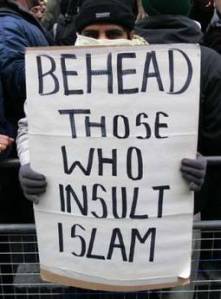 The so called pride event in USA embassy has in my opinion exposed these people to risk of death, social alienation and torture. The behavior which is indigenous will now become “western disease” which needs to be eradicated. Any one who is properly integrated in Pakistani society (not the isolated modern or semi modern Islands in Islamabad Lahore and Karachi) knows that homoerotic behavior is a significant part of local discourse and is not noticed or bothered much unless it crosses over from its designated sphere ie It is not worn on ones face or pumped up as a pride event. Rather is often a matter of laugh, taunt or dislike by friends and usually does not lead to much serious consequences. (Apart from few cases in recent past which are result of more Gay visibility and emergent homophobia). The strategy of modern gay liberation in a society where modern lifestyles have not been universally accepted can be counterproductive. The orientalist approach in this regard must be discarded. The movement must be integrated with movement to secularize the country. The queer activists need to integrate themselves to the wider political struggle in the country. They need to be part of the rank and file of the resistance movement. Winning the respect and acceptance of their colleges and comrades they need to introduce the agenda of sexual liberation in the emerging political leadership of the country. Not only this, they need to become part of this leadership.
The so called pride event in USA embassy has in my opinion exposed these people to risk of death, social alienation and torture. The behavior which is indigenous will now become “western disease” which needs to be eradicated. Any one who is properly integrated in Pakistani society (not the isolated modern or semi modern Islands in Islamabad Lahore and Karachi) knows that homoerotic behavior is a significant part of local discourse and is not noticed or bothered much unless it crosses over from its designated sphere ie It is not worn on ones face or pumped up as a pride event. Rather is often a matter of laugh, taunt or dislike by friends and usually does not lead to much serious consequences. (Apart from few cases in recent past which are result of more Gay visibility and emergent homophobia). The strategy of modern gay liberation in a society where modern lifestyles have not been universally accepted can be counterproductive. The orientalist approach in this regard must be discarded. The movement must be integrated with movement to secularize the country. The queer activists need to integrate themselves to the wider political struggle in the country. They need to be part of the rank and file of the resistance movement. Winning the respect and acceptance of their colleges and comrades they need to introduce the agenda of sexual liberation in the emerging political leadership of the country. Not only this, they need to become part of this leadership.
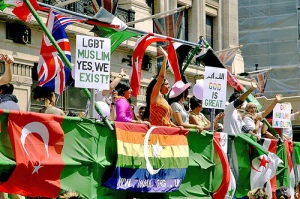
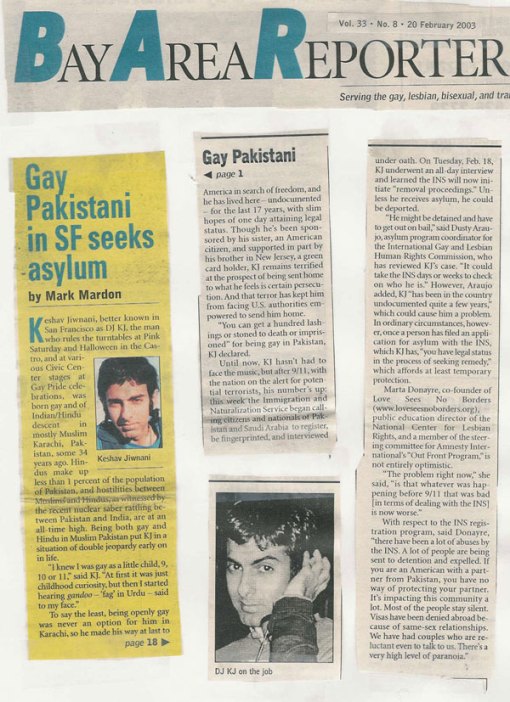
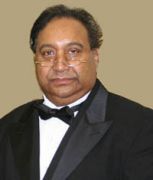 Dr Ifti Nasim is a famous poet of Urdu. He belongs to Pakistan and is based in United States. He is a great gay icon for the emerging gay liberation in muslim societies.
Dr Ifti Nasim is a famous poet of Urdu. He belongs to Pakistan and is based in United States. He is a great gay icon for the emerging gay liberation in muslim societies.

 There has been little serious discussion of this SC ruling online or in the print media: no speculation whatsoever over the meaning of gender in Pakistan, or whether this ruling is right in creating a hijra subject for the purposes of bureaucracy. What is going to constitute ‘the Third sex’? And what happens to those who do not qualify for this category? What about those ‘gender-confused’ people who do not want to be identified as ‘Third sex’, preferring instead to be identified as ‘male’ or ‘female’?. According to the article quoted above, the hijra are ‘left by the society to live by begging, dancing and prostitution’, to be exploited by the ‘self-styled guru’ – does it mean that after this ‘social uplift’ program, they will be made to give up their lifetyle? What if they can’t? Does discrimination go away after formal barriers to progress have been removed, or does it merely become invisible and more difficult to fight? With the avenus of empowerment formally open to them, wouldn’t the society find it easier to blame them if their ‘begging and dancing and prostitution’ continues? Will they be persecuted or will we realize that a ‘respectable’ life is just not possible for the hijra without a radical change in the society, its institutions and maybe our ideas of ‘respectable’?
There has been little serious discussion of this SC ruling online or in the print media: no speculation whatsoever over the meaning of gender in Pakistan, or whether this ruling is right in creating a hijra subject for the purposes of bureaucracy. What is going to constitute ‘the Third sex’? And what happens to those who do not qualify for this category? What about those ‘gender-confused’ people who do not want to be identified as ‘Third sex’, preferring instead to be identified as ‘male’ or ‘female’?. According to the article quoted above, the hijra are ‘left by the society to live by begging, dancing and prostitution’, to be exploited by the ‘self-styled guru’ – does it mean that after this ‘social uplift’ program, they will be made to give up their lifetyle? What if they can’t? Does discrimination go away after formal barriers to progress have been removed, or does it merely become invisible and more difficult to fight? With the avenus of empowerment formally open to them, wouldn’t the society find it easier to blame them if their ‘begging and dancing and prostitution’ continues? Will they be persecuted or will we realize that a ‘respectable’ life is just not possible for the hijra without a radical change in the society, its institutions and maybe our ideas of ‘respectable’?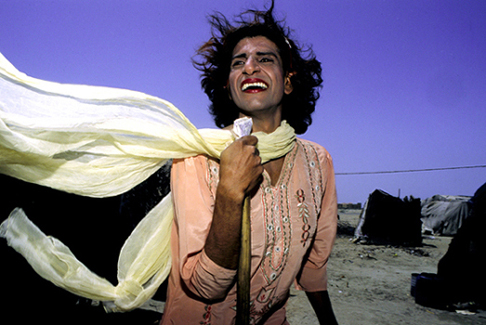
 “CONCLUSION 129. The notion of equality in the Indian Constitution flows from the ‘Objective Resolution’ moved by Pandit Jawaharlal Nehru on December 13, 1946. Nehru, in his speech, moving this Resolution wished that the House should consider the Resolution not in a spirit of narrow legal wording, but rather look at the spirit behind that Resolution.
“CONCLUSION 129. The notion of equality in the Indian Constitution flows from the ‘Objective Resolution’ moved by Pandit Jawaharlal Nehru on December 13, 1946. Nehru, in his speech, moving this Resolution wished that the House should consider the Resolution not in a spirit of narrow legal wording, but rather look at the spirit behind that Resolution.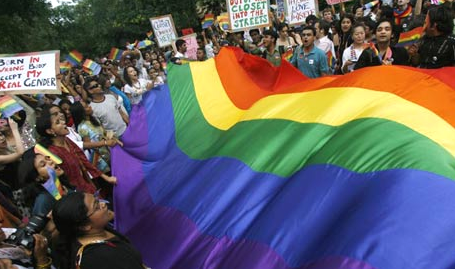


![361_people_a Thesis[war of Pakistani Identity]](https://sherryx.files.wordpress.com/2009/03/361_people_a.jpg?w=217&h=300)
![veiled Anti-thesis [War on women bodies]](https://sherryx.files.wordpress.com/2009/03/veiled.jpg?w=300&h=210)

 objectification in the media. Depression, appearance anxiety, body shame, sexual dysfunction, and eating disorders are only a few among the growing list of repercussions (Fredrickson & Noll, 1997). In addition to the objectification of women, the media commits another assault on the dignity of women. This assault is the dismemberment of women, and it has not received the attention it deserves (Kilbourne, 2002). Kilbourne (2002) pointed out that advertising is a 100 billion dollar a year industry. Each day we are exposed to more than 2000 ads. Advertising can be one of the most powerful sources of education in our society. Many women feel pressured to conform to the beauty standards of our culture and are willing to go to great lengths to manipulate and change their faces and bodies. Kilbourne suggests that women are conditioned to view their faces as masks and their bodies as objects. Through the mass media, women discover that their bodies and faces are in need of alteration, augmentation, and disguise. In addition, women are taught to internalize an observer’s perspective of their own bodies. This phenomenon is called objectification (Fredrickson & Noll, 1997). Advertisements are loaded with objectified women, and only recently have the effects of objectification been explored. However, the effects of the dismemberment of women in advertising have been neglected. Dismemberment advertisements highlight one part of a woman’s body while ignoring all the other parts of her body. Dismemberment ads portray women with missing appendages or substitute appendages. Of course the ads are only symbolic of dismemberment, but the symbolic imagery creates nearly the same effect.” The Objectification and Dismemberment of Women in Media , Kacey D Greening.
objectification in the media. Depression, appearance anxiety, body shame, sexual dysfunction, and eating disorders are only a few among the growing list of repercussions (Fredrickson & Noll, 1997). In addition to the objectification of women, the media commits another assault on the dignity of women. This assault is the dismemberment of women, and it has not received the attention it deserves (Kilbourne, 2002). Kilbourne (2002) pointed out that advertising is a 100 billion dollar a year industry. Each day we are exposed to more than 2000 ads. Advertising can be one of the most powerful sources of education in our society. Many women feel pressured to conform to the beauty standards of our culture and are willing to go to great lengths to manipulate and change their faces and bodies. Kilbourne suggests that women are conditioned to view their faces as masks and their bodies as objects. Through the mass media, women discover that their bodies and faces are in need of alteration, augmentation, and disguise. In addition, women are taught to internalize an observer’s perspective of their own bodies. This phenomenon is called objectification (Fredrickson & Noll, 1997). Advertisements are loaded with objectified women, and only recently have the effects of objectification been explored. However, the effects of the dismemberment of women in advertising have been neglected. Dismemberment advertisements highlight one part of a woman’s body while ignoring all the other parts of her body. Dismemberment ads portray women with missing appendages or substitute appendages. Of course the ads are only symbolic of dismemberment, but the symbolic imagery creates nearly the same effect.” The Objectification and Dismemberment of Women in Media , Kacey D Greening. 


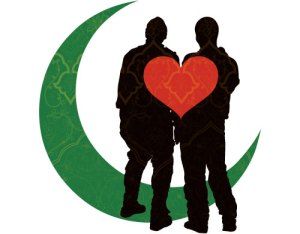

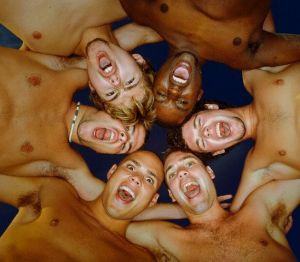 I recently discovered
I recently discovered











